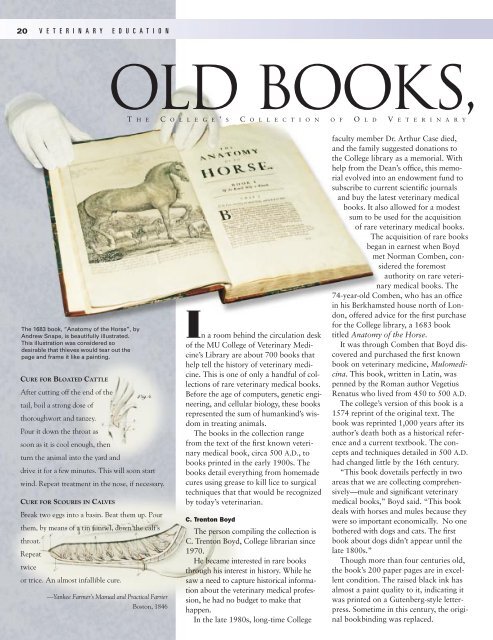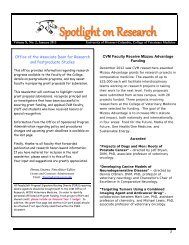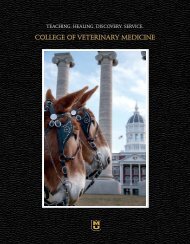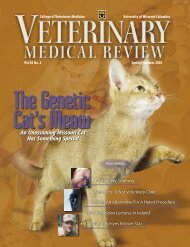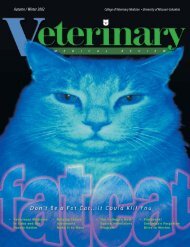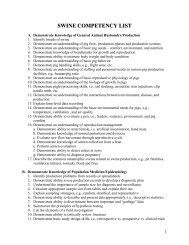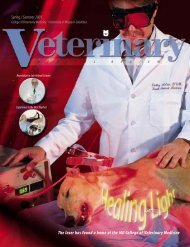... page 10 - University of Missouri College of Veterinary Medicine
... page 10 - University of Missouri College of Veterinary Medicine
... page 10 - University of Missouri College of Veterinary Medicine
You also want an ePaper? Increase the reach of your titles
YUMPU automatically turns print PDFs into web optimized ePapers that Google loves.
20 V E T E R I N A R Y E D U C A T I O N<br />
The 1683 book, “Anatomy <strong>of</strong> the Horse”, by<br />
Andrew Snape, is beautifully illustrated.<br />
This illustration was considered so<br />
desirable that thieves would tear out the<br />
<strong>page</strong> and frame it like a painting.<br />
CURE FOR BLOATED CATTLE<br />
After cutting <strong>of</strong>f the end <strong>of</strong> the<br />
tail, boil a strong dose <strong>of</strong><br />
thoroughwort and tanzey.<br />
Pour it down the throat as<br />
soon as it is cool enough, then<br />
turn the animal into the yard and<br />
drive it for a few minutes. This will soon start<br />
wind. Repeat treatment in the nose, if necessary.<br />
CURE FOR SCOURES IN CALVES<br />
Break two eggs into a basin. Beat them up. Pour<br />
them, by means <strong>of</strong> a tin funnel, down the calf’s<br />
throat.<br />
Repeat<br />
twice<br />
or trice. An almost infallible cure.<br />
Old Books,<br />
T H E C O L L E G E ’ S C O L L E C T I O N O F O L D V E T E R I N A R Y<br />
—Yankee Farmer’s Manual and Practical Farrier<br />
Boston, 1846<br />
In a room behind the circulation desk<br />
<strong>of</strong> the MU <strong>College</strong> <strong>of</strong> <strong>Veterinary</strong> <strong>Medicine</strong>’s<br />
Library are about 700 books that<br />
help tell the history <strong>of</strong> veterinary medicine.<br />
This is one <strong>of</strong> only a handful <strong>of</strong> collections<br />
<strong>of</strong> rare veterinary medical books.<br />
Before the age <strong>of</strong> computers, genetic engineering,<br />
and cellular biology, these books<br />
represented the sum <strong>of</strong> humankind’s wisdom<br />
in treating animals.<br />
The books in the collection range<br />
from the text <strong>of</strong> the first known veterinary<br />
medical book, circa 500 A.D., to<br />
books printed in the early 1900s. The<br />
books detail everything from homemade<br />
cures using grease to kill lice to surgical<br />
techniques that that would be recognized<br />
by today’s veterinarian.<br />
C. Trenton Boyd<br />
The person compiling the collection is<br />
C. Trenton Boyd, <strong>College</strong> librarian since<br />
1970.<br />
He became interested in rare books<br />
through his interest in history. While he<br />
saw a need to capture historical information<br />
about the veterinary medical pr<strong>of</strong>ession,<br />
he had no budget to make that<br />
happen.<br />
In the late 1980s, long-time <strong>College</strong><br />
faculty member Dr. Arthur Case died,<br />
and the family suggested donations to<br />
the <strong>College</strong> library as a memorial. With<br />
help from the Dean’s <strong>of</strong>fice, this memorial<br />
evolved into an endowment fund to<br />
subscribe to current scientific journals<br />
and buy the latest veterinary medical<br />
books. It also allowed for a modest<br />
sum to be used for the acquisition<br />
<strong>of</strong> rare veterinary medical books.<br />
The acquisition <strong>of</strong> rare books<br />
began in earnest when Boyd<br />
met Norman Comben, considered<br />
the foremost<br />
authority on rare veterinary<br />
medical books. The<br />
74-year-old Comben, who has an <strong>of</strong>fice<br />
in his Berkhamsted house north <strong>of</strong> London,<br />
<strong>of</strong>fered advice for the first purchase<br />
for the <strong>College</strong> library, a 1683 book<br />
titled Anatomy <strong>of</strong> the Horse.<br />
It was through Comben that Boyd discovered<br />
and purchased the first known<br />
book on veterinary medicine, Mulomedicina.<br />
This book, written in Latin, was<br />
penned by the Roman author Vegetius<br />
Renatus who lived from 450 to 500 A.D.<br />
The college’s version <strong>of</strong> this book is a<br />
1574 reprint <strong>of</strong> the original text. The<br />
book was reprinted 1,000 years after its<br />
author’s death both as a historical reference<br />
and a current textbook. The concepts<br />
and techniques detailed in 500 A.D.<br />
had changed little by the 16th century.<br />
“This book dovetails perfectly in two<br />
areas that we are collecting comprehensively—mule<br />
and significant veterinary<br />
medical books,” Boyd said. “This book<br />
deals with horses and mules because they<br />
were so important economically. No one<br />
bothered with dogs and cats. The first<br />
book about dogs didn’t appear until the<br />
late 1800s.”<br />
Though more than four centuries old,<br />
the book’s 200 paper <strong>page</strong>s are in excellent<br />
condition. The raised black ink has<br />
almost a paint quality to it, indicating it<br />
was printed on a Gutenberg-style letterpress.<br />
Sometime in this century, the original<br />
bookbinding was replaced.


